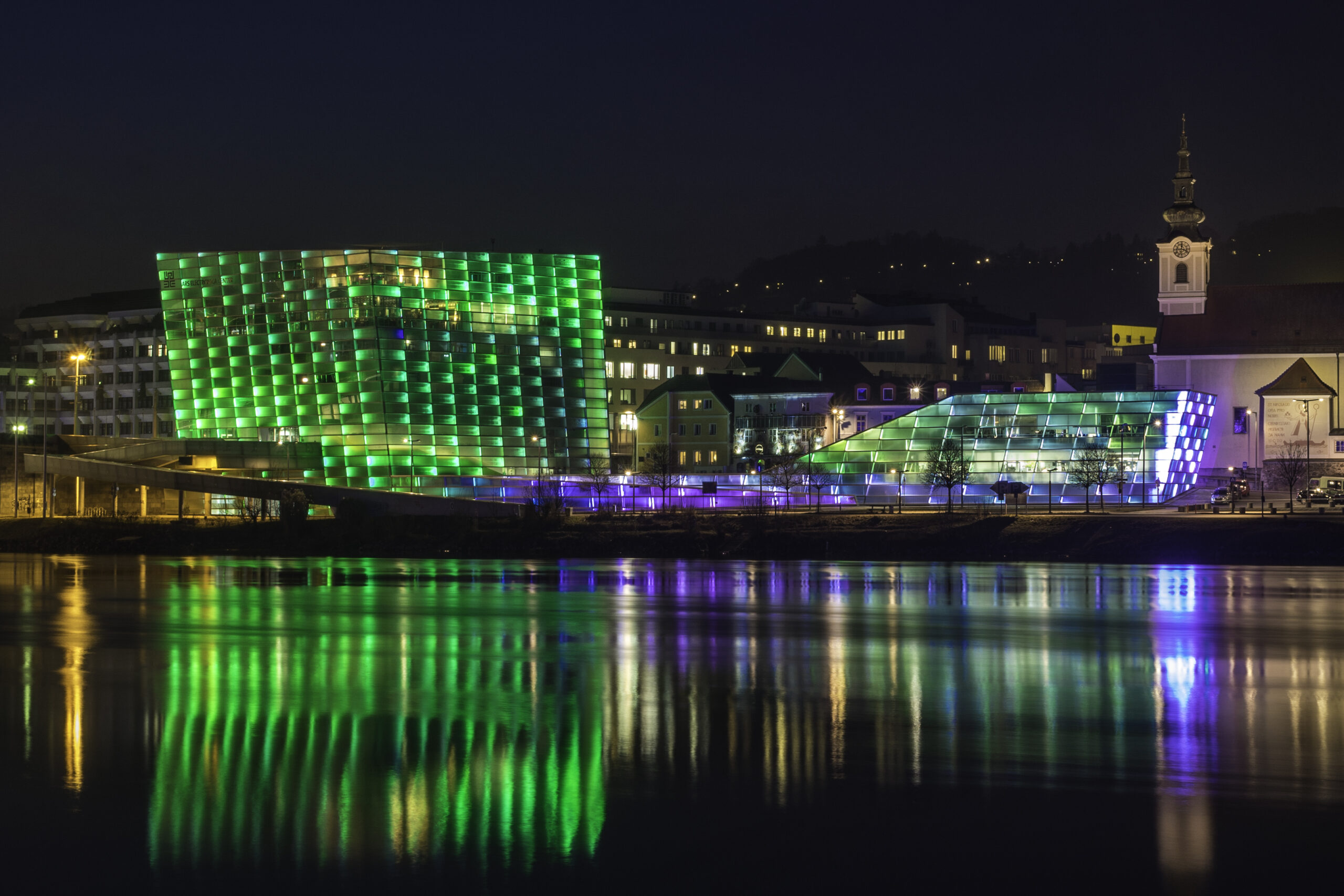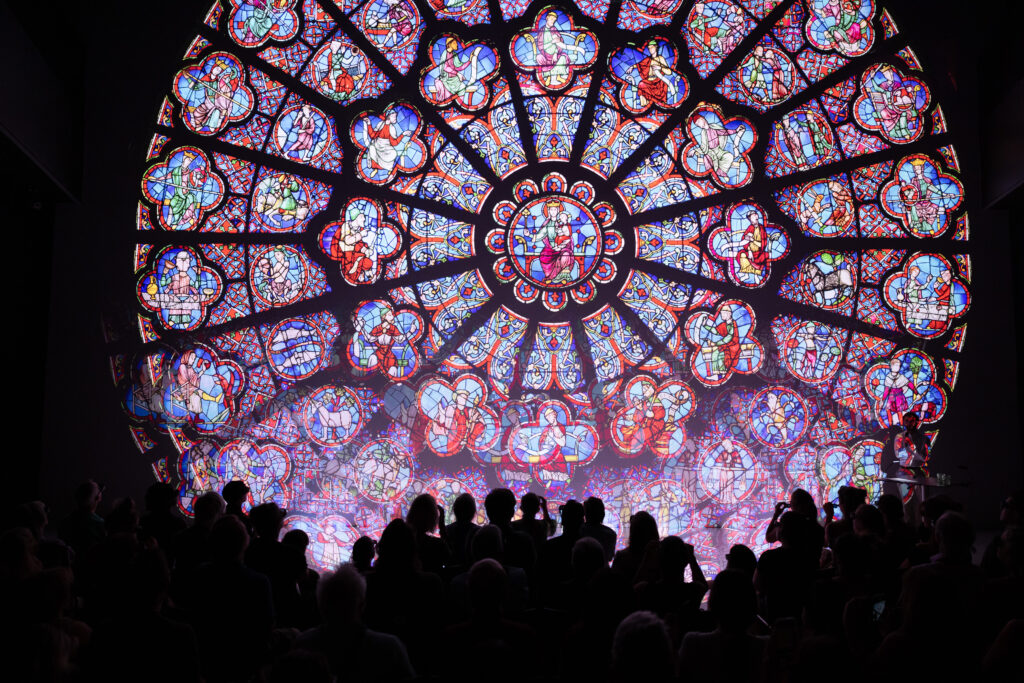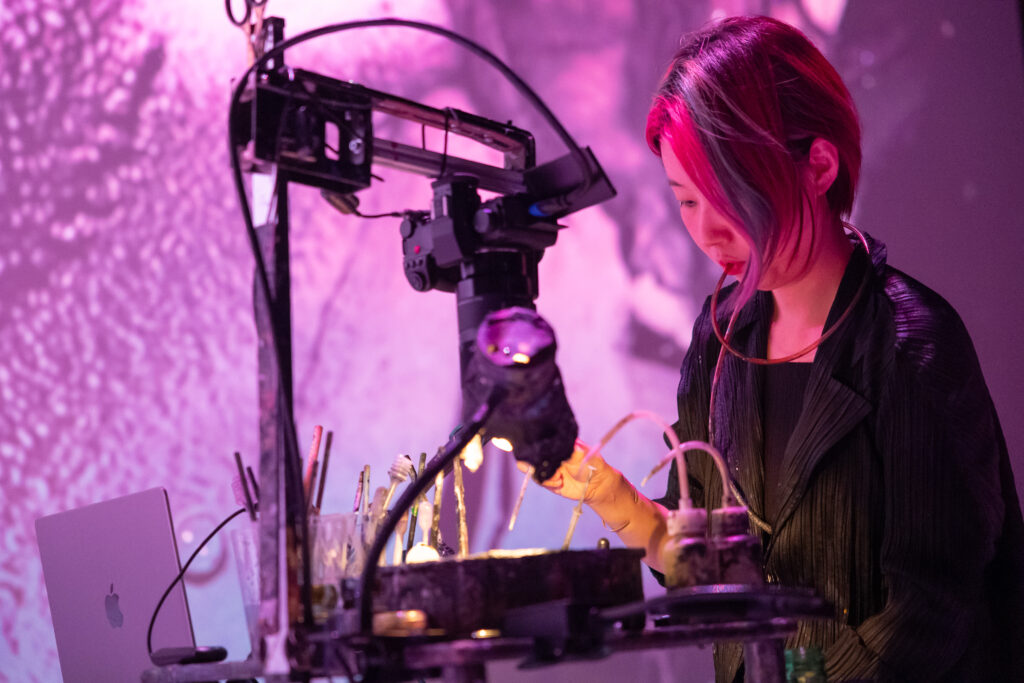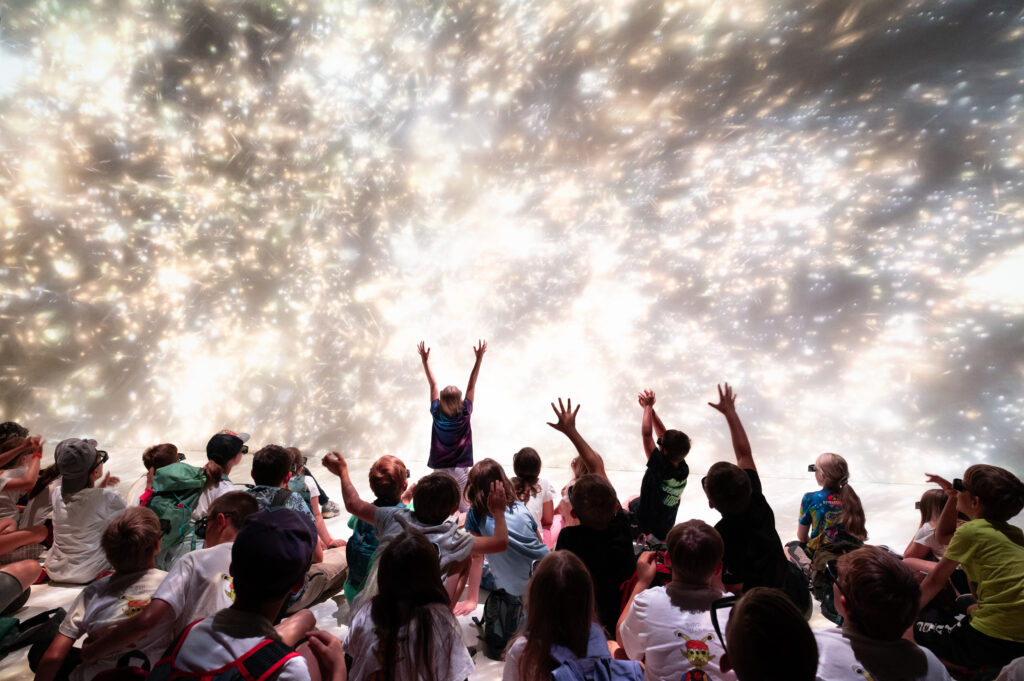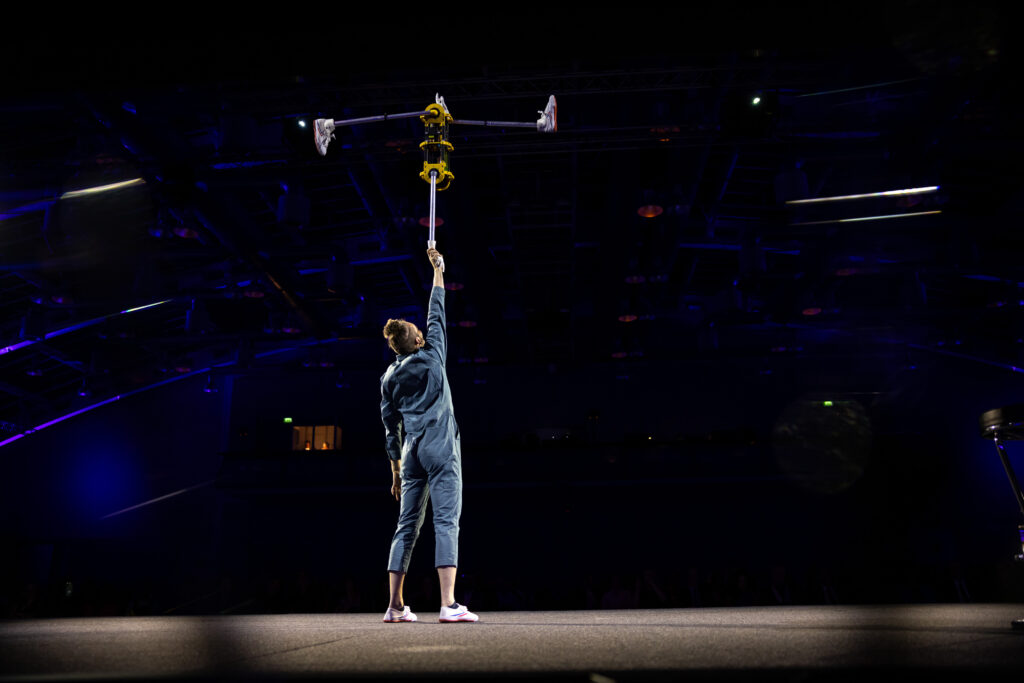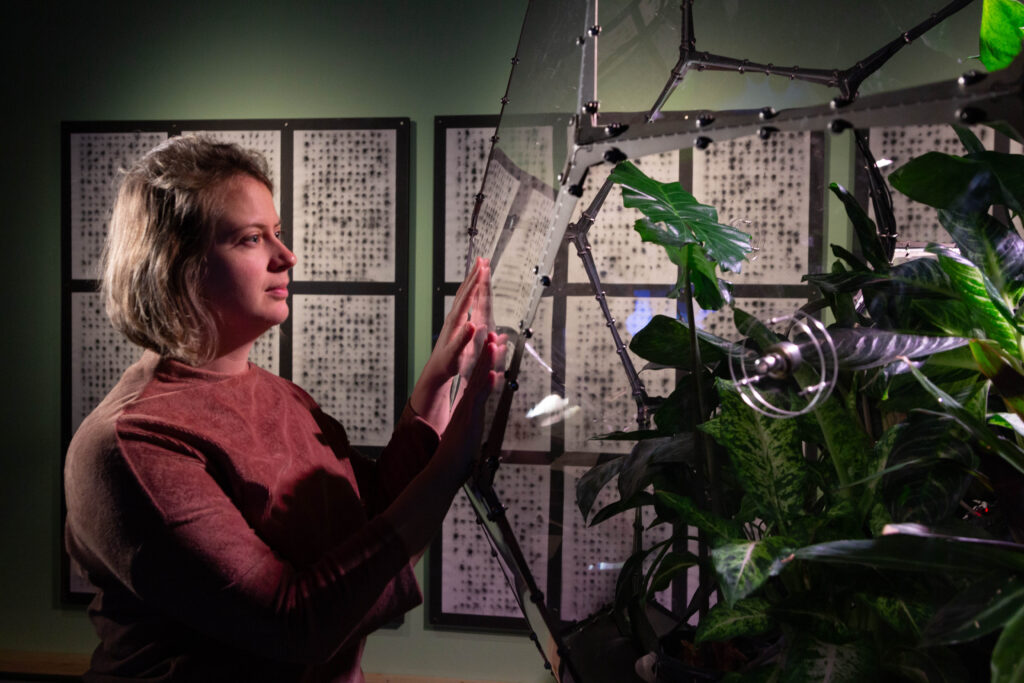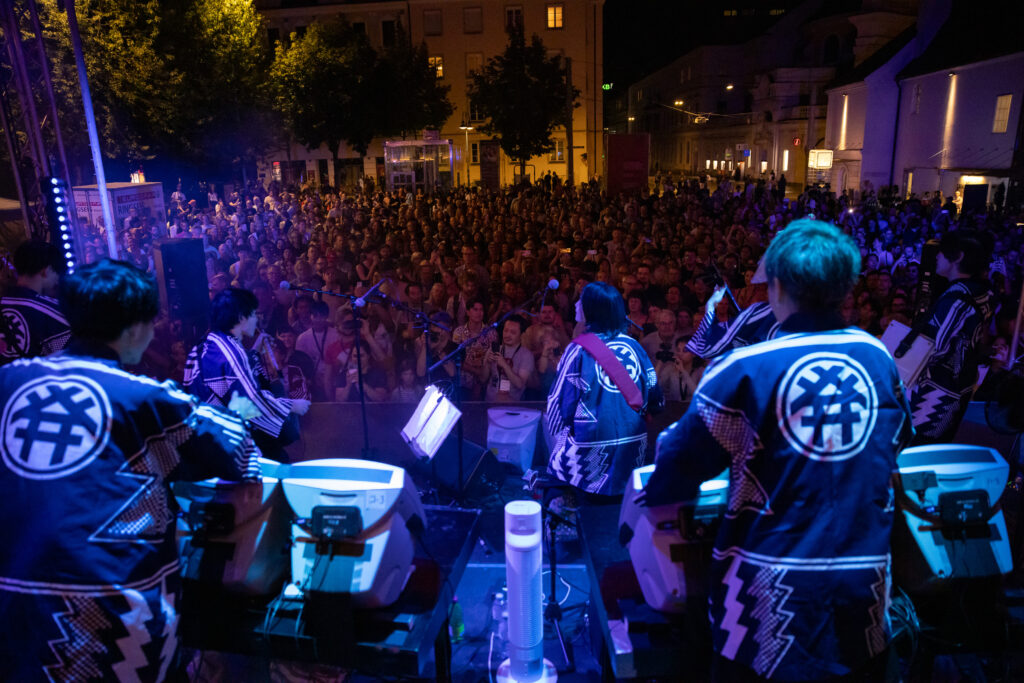- Press Text as PDF
- Read more about the year 2024 on our blog:
- Images via Flickr
(Linz, February 6, 2025) New exhibitions at the Ars Electronica Center in Linz, 5,262 entries from all over the world for six competitions and prize money totalling 228,600 euros, record attendance at the
Ars Electronica Festival, 19 EU projects with more than 120 partner institutions, sensational international commissions – Ars Electronica looks back on a successful year in 2024.
“More than 170,000 visitors and event guests came to the Ars Electronica Center last year, and the Ars Electronica Festival set a new record with more than 112,000 visits at 18 different venues. To date, Ars Electronica Solutions has thrilled more than 900,000 visitors with a gigantic commissioned work in the Gasometer in Oberhausen and realized immersive Deep Spaces in Shanghai, Hangzhou and Zagreb. The Ars Electronica Futurelab conducted research and development for companies such as Godot, Toyota Conic Alpha and Hakuhodo, Ars Electronica Export realized projects in Poland, Türkiye, South Korea and Taiwan, and our Platform Europe bundled 19 EU projects involving more than 120 partner institutions,” says Gerfried Stocker, Ars Electronica’s Artistic director, summarizing the key data for 2024. “The sheer number and breadth of these activities reflect the networks we have established and consolidated around the globe over the course of decades.”
“Equally important to Ars Electronica’s success are its local roots. Throughout the year, all of our departments work closely with local art and cultural institutions, universities, colleges and businesses. In addition, we are supported by a large number of regional partners and sponsors,” says Markus Jandl, Ars Electronica’s Commercial Director, underscoring the good business relations in Linz and Upper Austria.
“The Ars Electronica Center and the Ars Electronica Festival in particular build bridges between the international art and creative scene, the topics discussed there and our city, where this input falls on fertile ground,” says Dietmar Prammer, Mayor Designate of the City of Linz. “For the people of Linz, this means not only exciting content, but above all artistic offerings of a quality and quantity that are otherwise only to be found in metropolises.”
“The Ars Electronica team is doing an incredibly successful job for Linz, both locally and internationally. The success figures for 2024 once again impressively confirm this. Particularly in these times of digital upheaval, the importance of Ars Electronica for Linz as a cultural, educational and economic center cannot be overstated,” emphasizes Doris Lang-Mayerhofer, City Councilor for Culture and Chair of Ars Electronica’s Supervisory Board, adding, “From educational programs for all school types and age groups, to contributions to the OÖ KulturEXPO 2024, the Connected Earth exhibition and the virtual Notre-Dame in Deep Space, to the Ars Electronica Festival at 18 locations – more than ever, Ars Electronica 2024 was also present in Linz.”
So Much New at the Museum of the Future
The Ars Electronica Center continues to be very popular, with more than 170,000 visitors and event guests in 2024, which is above the long-term average. The number of schoolchildren visiting the Ars Electronica Center as part of a school class remains gratifying: 36,264 children and young people visited in 2024.
The activities sponsored by the Province of Upper Austria and the City of Linz during the Anton Bruckner Jubilee Year as part of the first OÖ KulturEXPO were a real crowd-puller. The Deep Space application Playing Anton and the immersive sound installation Being Anton – both conceived and realized by the Ars Electronica Futurelab – invited visitors to explore the musical sophistication of Anton Bruckner and his personal development in the 19th century.
Another highlight was the opening of the permanent exhibition Connected Earth in close cooperation with the Austrian Climate and Energy Fund. Since November 2024, art installations and interactive stations have been highlighting the interactions between nature, human infrastructure, climate change and energy transition. International artists and Austrian partners are involved, including WIVA P&G, Robert Bosch AG, Linz University of Applied Sciences, LINZ AG with RAG Austria AG and KONTEXT Institute for Climate Issues.
In Deep Space 8K, the focus on cultural heritage was further expanded. For instance, the first cooperation with the Museo Nacional Thyssen-Bornemisza Madrid brought the work of Vittore Carpaccio to Linz. Now it is also possible to take a look behind the scenes at Notre-Dame de Paris thanks to Notre-Dame Immersive, a production of the Ars Electronica Futurelab in collaboration with the French start-ups Iconem and Histovery. On the basis of real data sets, visitors to Linz can take a 3D stroll through the Parisian cathedral. The popularity of the project in Linz led to a commission from the Museum of Fine Arts in Houston, USA. Since November 2024, the Ars Electronica Futurelab has been showing Notre-Dame Cathedral: An Immersive Experience, an animated 2D journey through Notre Dame.
The STEM experience space missimo, operated by Ars Electronica on behalf of the Kaiserschild Private Foundation, successfully completed its first “school year” in 2024: The converted truck visited 100 schools throughout Austria from the fall of 2023 to the end of 2024, reaching 4,241 students. Ars Electronica infotrainers accompanied the learning units with a total of 264 primary school classes.
Children and young people were also the focus of Mission X – Train Like an Astronaut: More than 1,000 students came to the Ars Electronica Center on two separate days for the finals of the competition. In addition, some 200 students and other interested visitors attended the CanSat competition in 2024 in Suben, where Austria’s only annual rocket launch can be experienced. Both competitions are organized by ESERO Austria (based at the Ars Electronica Center).
Ars Electronica Festival: Record Attendance
More than 112,000 visits speak for themselves: The Ars Electronica Festival from September 4-8, 2024, under the motto HOPE – who will turn the tide, was a great success. A total of 1,260 artists, scientists, developers, entrepreneurs and activists from 67 countries were guests at ten Official Locations and eight Featured Locations, making it possible to realize a total of 498 events.
The festival’s main location in downtown Linz, POSTCITY, was a huge success. 80,000 square meters were transformed into an exciting exhibition and experimental space, as well as a discussion forum for experts from the fields of art, science and industry. Among the high-profile speakers at the symposium on the festival theme were British neuroscientist Anil Seth, AI in ART Award-winning filmmaker Paul Trillo (US), entrepreneur Agnes Aistleitner Kisuule (AT/UG) – listed in Forbes 30 under 30 – and S+T+ARTS Prize winners Kate Crawford (AU) and Vladan Joler (RS).
In 2024, the Linz festival mile offered numerous premieres: for the first time, the Lentos Kunstmuseum Linz became the stage for the renowned Prix Ars Electronica exhibition, and the JKU MED Campus was also a new festival location. There, innovative Art+Science projects, outstanding works by the Linz Institute of Technology and interactive XR experiences fascinated the audience. Another first was the holding of the Prix Ars Electronica Award Ceremony at the Design Center Linz. On the main square, the University of Arts Linz once again showed young media art in both bridgehead buildings and invited the Moholy-Nagy University of Budapest to display work at the splace gallery on the main square.
The Big Concert Night with the Cello Octet Amsterdam (NL) and Nick Verstand (NL) and the Futurelab Night in Deep Space 8K with impressive works from artistic research were particularly well received. Maki Namekawa (AT/JP) and Dennis Russell Davies (AT/US) shone in their four-handed piano version of Bedřich Smetana’s Ma Vlast. As a special highlight, Maki Namekawa and the Filharmonie Brno presented the Austrian premiere of the Mishima Concerto by Philip Glass (US).
Ars Electronica Export
In 2024, the Ars Electronica Export department assigned to the Ars Electronica Festival curated a total of nine exhibitions, implemented 62 events in 26 countries with more than 187,000 visits, and collaborated with artists worldwide. Noteworthy was the collaboration with Taiwanese institutions such as TAICCA and the National Taiwan Museum of Fine Arts (NTMoFA), as well as the presence at the Silesian Science Festival in Katowice, the KI Festival in Heilbronn and the Gwangyang-Linz Media Art Exchange Exhibition. More than 3,000 animation fans in 19 countries also experienced the Ars Electronica Animation Festival On Tour.
In spring, Ars Electronica Export designed the opening of the Cubuklu Silos Digital Art Museum in Istanbul with a specially curated group exhibition. In July 2024, the Catalyst lab – The Making of Tomorrow exhibition at the European Patent Office ended with great success.
Ars Electronica Futurelab: Expanded Networks
In its function as an artistic research and development laboratory, the Ars Electronica Futurelab collaborated with partners from the worlds of business, culture, research, art and education on more than fifty projects in the year 2024. The variety is remarkable.
In the weeks leading up to the parliamentary elections in September 2024, the Pillars of Democracy project invited visitors to use their digital silhouettes to take a stand on issues such as respect, solidarity, voting and participation. In Vienna, projections on LED panels on the pillars of the Parliament building made democracy a personal experience. In Linz, a multimedia exhibition was developed in collaboration with the Diocese of Linz to celebrate the 100th anniversary of the St. Mary’s Cathedral.
Since the summer of 2024, the Ars Electronica Futurelab has been working on the Waltz Symphony project on behalf of the Johann Strauss Festival Year 2025. The central question is how composers can use the creative potential of AI technologies. The starting point is a version of the AI system Ricercar (developed at the Ars Electronica Futurelab since 2019), that has been specially adapted for this project and trained with the music of Johann Strauss.
In 2024, the Futurelab continued to explore the intersection of art and technology, for example by continuing the EU’s SHARESPACE program. Playful, interactive works were developed that encourage the audience to collaborate through movement and body language in Deep Space 8K.
Ars Electronica Japan
The Ars Electronica Japan initiative, based at the Ars Electronica Futurelab, has become a central pillar. In 2024, the Ars Electronica Futurelab has succeeded in creating a network for innovative art in Japan through its guidance and collaboration with CCBT (Civic Creative Base Tokyo) and the Matsudo International Science and Art Festival. In addition, Ars Electronica Japan is involved in artistic research into Data Art & Science with Toyota Conic Alpha, Future Print with Dai Nippon Printing, Future Team with Ricoh and Future Ink with WACOM.
Together with Hakuhodo, one of Japan’s leading communication design companies, the initiative is at the forefront of the art thinking community. The collaboration with tech start-up Godot also continued in 2024.
Ars Electronica Solutions: Regional & International Demand
A record 915,900 visitors have flocked to the newly opened “Planet Ocean” exhibition at the Oberhausen Gasometer, Europe’s tallest exhibition hall, since its opening in March 2024. The Wave is responsible for this record number – a successfully implemented commissioned work by Ars Electronica Solutions. On a 1,200-square-meter projection surface, lifelike 3D animations enable an immersive dive into the underwater world. In view of the great success, the exhibition has been extended until November 30, 2025. Plans for a continuation of the collaboration with the Oberhausen Gasometer are already in preparation.
In 2024, the technology of Deep Space 8K by Ars Electronica was exported three times as a product, set up on site and successfully opened: Two immersive projection spaces modeled on the Linz installation opened at the West Bund Museum Shanghai and the M511 complex in Hangzhou. Since October 2024, visitors to the Croatian Natural History Museum (Hrvatski prirodoslovni muzej) in Zagreb have also been able to experience a small-scale Deep Space that is every bit as innovative and interactive as the original in Linz.
Ars Electronica Solutions is not only in great demand internationally, it is also in great demand in Austria. Last year, Ars Electronica Solutions was involved in the development of the Innovation Hub for the reopening of the Haus der Wirtschaft of the WKOÖ. Forty interactive screens and mirrored glass panels form the “Julius Raab Band,” which visualizes the WKOÖ’s global network and showcases local start-ups.
The concept of “Science Experience” was also a top priority in 2024. Interactive stations were developed for the exhibition “KLIMA. WISSEN. HANDELN.” at the Technical Museum Wien and the visitor center of the Dachstein Glacier Cable Cars, which vividly explain the global and regional connections of the climate crisis and call for action.
19 Ongoing EU Projects & Over 120 Partners
In 2024, Ars Electronica’s activities in the area of European cooperation were combined under the new brand Ars Electronica Platform Europe. Within this framework, Ars Electronica is developing new narratives about the technosphere, the environmental crisis and sociopolitical developments – but is also focusing on new interdisciplinary approaches that bring art and society into conversation with each other.
Ars Electronica is pursuing these goals together with more than 120 partner institutions throughout Europe in the course of 19 EU-funded projects, most of which are financed by Creative Europe and the Horizon Europe research funding program.
The S+T+ARTS Ec(h)o project – in the course of which the STARTS Prize 2025 will be awarded for the tenth time – and the cooperation within the framework of the European Digital Deal are coordinated by Ars Electronica. The European Union Prize for Citizen Science, which carries an annual endowment of 100,000 euros, is also an Ars Electronica project funded by the EU. With the STARTS4Africa project, which was responsible for the first STARTS Prize Africa in 2024, European partnerships were extended beyond the borders of the continent.
The award-winning projects and many other results of the numerous collaborations will once again be presented at this year’s Ars Electronica Festival. Many of the partner institutions, including Sónar from Barcelona, the Salzburg Festival, Onassis Stegi from Athens, the European Theater Convention and Trinity College Dublin, are expected to be present in Linz.
A Look Ahead to 2025
The Ars Electronica Festival 2025 will take place in Linz from September 3-7. The main location will once again be POSTCITY. A wide range of artistic works can be expected, as well as panels, talks and conferences with international speakers.
As a prelude to a new collaboration with the Brucknerfest, the Ars Electronica Opening (with the Bruckner Orchester Linz) and the Big Concert Night (with a project by David Bösch and Dennis Russell Davies) will also be presented as guest contributions from Ars Electronica to the program of the Brucknerfest. More details will be presented on April 2, 2025, at a press conference on this year’s festival theme at the Ars Electronica Center.
The exhibition TIME OUT .13 is on view at the Ars Electronica Center through March 9, 2025, and presents works by students in the “Time-Based and Interactive Media Art” department at the University of Art and Design Linz. Those who take advantage of the last weekend of the exhibition to visit will arrive just in time for the International Women’s Day celebrations in Deep Space 8K on March 8. Works by international female media artists will be shown there, including the audiovisual essay by Enar de Dios Rodríguez, winner of the Marianne.von.Willemer Prize for Digital Media.
Despite economically uncertain times, Ars Electronica has succeeded in maintaining a stable volume of commissions beyond the museum and festival: The Ars Electronica Futurelab is working with the Mozarteum University Salzburg on the development of its X-Reality Lab: an immersive experimental space for extended reality for performative art as well as scientific research. The core is the development of open source software by the Futurelab, which enables students and artists to develop a wide range of projects in the X-Reality Lab. The Waltz Symphony project is being realized on behalf of the Johann Strauss Festival. The result is a newly composed piece of music that was created in a creative exchange between humans and AI. The world premiere of the work will take place in Vienna in November 2025 – excerpts from it will be performed by the Bruckner Orchester Linz at the Ars Electronica Opening in Linz’s St. Mary’s Cathedral in September 2025. In addition, the Ars Electronica Futurelab is working on a large-scale project for a renowned German software company.
Ars Electronica Solutions is already working on the implementation of the next Deep Space in the CODE – Center of Digital Experiences in Veszprém/Hungary. At the same time, the team is working on projects in Steyr and Klagenfurt: In the capital of Carinthia, the modernization of the headquarters of the Carinthian Sparkasse is on the agenda. In Steyr, the Museum of Working World is being updated: together with the Upper Austrian Chamber of Labor and Smesh OG, Ars Electronica Solutions is responsible for the new WORKLAB-exhibition and numerous digital installations.
